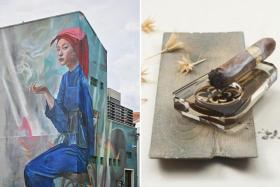Much smoke over Samsui mural
Growing up in the 1960s and 1970s, I have personally seen samsui women hard at work at construction sites.
In his article Samsui Women published by the National Library Board, writer Vincent Koh Qi Rui wrote they were among the 200,000 Chinese female migrants who came to Singapore between 1934 and 1938. So I missed seeing a young samsui woman, like the one depicted in the Chinatown mural, by about three decades.
Dressed in their traditional dark-blue samfu with a distinctive red headdress, the elderly samsui women I saw hauled bricks and building materials in rattan scoops.
They were wary of strangers and, to save money, prepared their meals and ate among themselves. Many of the women were also celibate.
Their contribution to Singapore’s development was recognised in the Samsui Women television drama series produced in 1986 as well as in a play titled Samsui Women: One Brick At A Time, performed in 2015 at the Esplanade – Theatres on the Bay.
Then, during the 2018 National Day Parade, a short film highlighted the real-life story of a former samsui woman.
Over time, they receded quietly into the annals of history until the mural of the young samsui woman with a cigarette appeared.
A heated debate ensued when Mr Sean Dunston, a Singapore-based American artist who painted the mural, revealed a directive by the Urban Redevelopment Authority (URA) to remove the cigarette.
URA had even cited a comment from a member of the public who said the woman “looks more like a prostitute than a hard-working samsui woman”.
To be fair to URA, there are long-established rules against public displays promoting or glamorising smoking. What’s more: no one applied for approval before commissioning the mural.
Despite all that, there were, on the flip side, accusations of blatant censorship of creativity and artistic expression.
If historical accuracy is the issue, one observer noted that the woman should be smoking an “ang hoon”, which refers to the cheaper self-rolled cigarettes. Other critics took issue with her smooth elegant hands and asked why they were not calloused. For others, she could be doing any number of things a samsui woman would do when resting – besides smoking.
However, there are artists who believe that art should create controversy.
On July 10, the URA and the Ministry of Health decided that the mural can stay, but have imposed a fine of $2,000 on the building owner for not obtaining approval.
However, the authorities will work with the building owner to mitigate any impact that the mural may have in promoting smoking, without modifying the mural itself.
That should clear the air.
Get The New Paper on your phone with the free TNP app. Download from the Apple App Store or Google Play Store now


